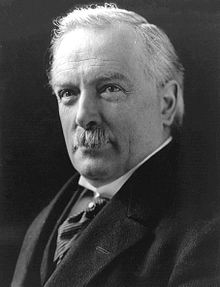David Lloyd George
David Lloyd George, 1st Earl Lloyd-George of Dwyfor,[a] OM, PC (17 January 1863 – 26 March 1945) was the British Prime Minister during the last half of World War I. He was Prime Minister for six years, between 1916 and 1922.
David Lloyd George | |
|---|---|
 | |
| Prime Minister of the United Kingdom | |
| In office 6 December 1916 – 19 October 1922 | |
| Monarch | George V |
| Preceded by | H. H. Asquith |
| Succeeded by | Bonar Law |
| Leader of the Liberal Party | |
| In office 14 October 1926 – 4 November 1931 | |
| Preceded by | H. H. Asquith |
| Succeeded by | Herbert Samuel |
| Secretary of State for War | |
| In office 6 July 1916 – 5 December 1916 | |
| Prime Minister | H. H. Asquith |
| Preceded by | The Earl Kitchener |
| Succeeded by | The Earl of Derby |
| Minister of Munitions | |
| In office 25 May 1915 – 9 July 1916 | |
| Prime Minister | H. H. Asquith |
| Preceded by | Office created |
| Succeeded by | Edwin Montagu |
| Chancellor of the Exchequer | |
| In office 12 April 1908 – 25 May 1915 | |
| Prime Minister | H. H. Asquith |
| Preceded by | H. H. Asquith |
| Succeeded by | Reginald McKenna |
| President of the Board of Trade | |
| In office 10 December 1905 – 12 April 1908 | |
| Prime Minister | Henry Campbell-Bannerman H. H. Asquith |
| Preceded by | The Marquess of Salisbury |
| Succeeded by | Winston Churchill |
| Father of the House | |
| In office 31 May 1929 – 13 February 1945 | |
| Preceded by | T. P. O'Connor |
| Succeeded by | The Earl Winterton |
| Member of Parliament for Carnarvon Boroughs | |
| In office 10 April 1890 – 13 February 1945 | |
| Preceded by | Edmund Swetenham[1] |
| Succeeded by | Seaborne Davies |
| Member of the House of Lords Lord Temporal | |
| In office 1 January 1945 – 26 March 1945 Hereditary peerage | |
| Preceded by | peerage created |
| Succeeded by | The 2nd Earl Lloyd-George of Dwyfor |
| Personal details | |
| Born | 17 January 1863 Chorlton-on-Medlock, Manchester, Lancashire, England |
| Died | 26 March 1945 (aged 82) Tŷ Newydd, Caernarfonshire, Wales |
| Resting place | Llanystumdwy, Gwynedd, Wales |
| Citizenship | British |
| Nationality | Welsh |
| Political party | Liberal (1890–1916 and 1924–45) National Liberal (1922–23) |
| Spouse(s) | |
| Children | 5, including Richard, Gwilym and Lady Megan |
| Parents |
|
| Profession | solicitor, politician |
| Signature | |
Early life
changeLloyd George was born in Chorlton-on-Medlock, Manchester, Lancashire, England to Welsh parents. His father, who died before Lloyd George was two-years old, was a teacher and a farmer. When he was young, he lived with his mother and his brother. When he was 21, Lloyd George became a lawyer and opened an office in the back of his brother's house.
Political career
changeLloyd George's law practice was a success. Shortly after opening it, Lloyd George became interested in politics. He began working with the Liberal Party. He was elected as a Member of Parliament (MP) on 13 April 1890. Lloyd George would serve as an MP until 1945. In the House of Commons, Lloyd George worked to promote Welsh issues, fought against the Second Boer War and campaigned for education reform.
In 1905, Lloyd George was selected to become a cabinet minister. He served as President of the Board of Trade (1905–1908) and Chancellor of the Exchequer (1908–1915). After World War I started, he held the positions of Minister of Munitions (1915) and War Secretary (1916).
By the end of 1916, the war was going badly for Great Britain. Lloyd George gathered together a coalition (a type of political team) of Liberal and Conservative MPs to form a new government. On 5 December 1916, Prime Minister H. H. Asquith resigned, and Lloyd George took his place. Lloyd George's government introduced conscription (forcing men to join the armed forces) and rationing (placing limits on the amount of food someone can buy) by the end of the war.
After the war, Lloyd George represented Britain at the Versailles Peace Conference and helped create the Irish Free State. By 1922, Lloyd George's coalition was breaking apart. In October 1922, the Conservative Party led by Andrew Bonar Law won the election. Lloyd George remained an MP, however, until 1945.
In 1945, he was given the titles Earl Lloyd George of Dwyfor and Viscount Gwynedd. He was to take a seat in the House of Lords, but he died before he could do so.
References
change- ↑ "David Lloyd George Exhibition". National Library of Wales. March 1995. Retrieved 14 February 2016.
Notes
- ↑ Under the rules governing titles within the peerage, Lloyd George's name in his title was hyphenated even though his surname was not.